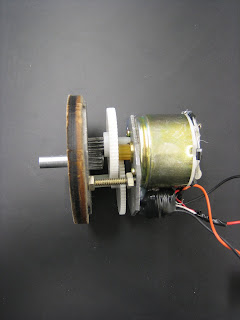 Belt buckle pinhole camera for Pipo Nguyen-Duy:
Belt buckle pinhole camera for Pipo Nguyen-Duy:
http://drinkicd.com/
13 years ago
Works
 This three wheeled skateboard built at Oberlin came to be known as the Electroped and was constructed using the propulsion system from a broken electric scooter I found and spare parts from other projects. Acceleration and breaking are accomplished through the levers mounted on the control cable, and steering, as in a normal skateboard, is controlled by leaning. While the vehicles rate of acceleration is lack luster due to its low wattage motor, it can never the less reach a respectable top speed of 14mph.
This three wheeled skateboard built at Oberlin came to be known as the Electroped and was constructed using the propulsion system from a broken electric scooter I found and spare parts from other projects. Acceleration and breaking are accomplished through the levers mounted on the control cable, and steering, as in a normal skateboard, is controlled by leaning. While the vehicles rate of acceleration is lack luster due to its low wattage motor, it can never the less reach a respectable top speed of 14mph. 
 Drive train and battery detail
Drive train and battery detail


 type 1 cardboard chair (laminated recycled cardboard)
type 1 cardboard chair (laminated recycled cardboard) type 1 cardboard chair top
type 1 cardboard chair top
 ipod speakers closed
ipod speakers closed 

 type 1 can amp open, access to the battery pulling the spring loaded spkear off the top of the amp
type 1 can amp open, access to the battery pulling the spring loaded spkear off the top of the amp dynamo flashlight,
dynamo flashlight, dynamo flashlight guts
dynamo flashlight guts


 Scanner (MDF, pocket radios, stadium horns, paper cups, soda bottles, wire, string, gear motor)
Scanner (MDF, pocket radios, stadium horns, paper cups, soda bottles, wire, string, gear motor) 


 container for memories and nightmares (reclaimed wood from poplar food crate, bottles[sealed], extraction hammer: machined mild steel, hickory)
container for memories and nightmares (reclaimed wood from poplar food crate, bottles[sealed], extraction hammer: machined mild steel, hickory)

 extraction hammer detail
extraction hammer detail a gift (coptic stitch book: black walnut, paper, embroidery thread)
a gift (coptic stitch book: black walnut, paper, embroidery thread)

 key detail
key detail cross member insulator bulb detail
cross member insulator bulb detail
